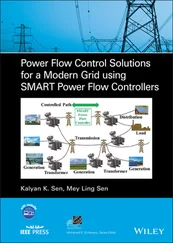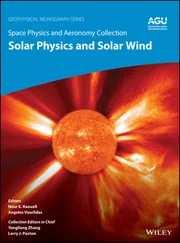Rajiv K. Varma - Smart Solar PV Inverters with Advanced Grid Support Functionalities
Здесь есть возможность читать онлайн «Rajiv K. Varma - Smart Solar PV Inverters with Advanced Grid Support Functionalities» — ознакомительный отрывок электронной книги совершенно бесплатно, а после прочтения отрывка купить полную версию. В некоторых случаях можно слушать аудио, скачать через торрент в формате fb2 и присутствует краткое содержание. Жанр: unrecognised, на английском языке. Описание произведения, (предисловие) а так же отзывы посетителей доступны на портале библиотеки ЛибКат.
- Название:Smart Solar PV Inverters with Advanced Grid Support Functionalities
- Автор:
- Жанр:
- Год:неизвестен
- ISBN:нет данных
- Рейтинг книги:3 / 5. Голосов: 1
-
Избранное:Добавить в избранное
- Отзывы:
-
Ваша оценка:
- 60
- 1
- 2
- 3
- 4
- 5
Smart Solar PV Inverters with Advanced Grid Support Functionalities: краткое содержание, описание и аннотация
Предлагаем к чтению аннотацию, описание, краткое содержание или предисловие (зависит от того, что написал сам автор книги «Smart Solar PV Inverters with Advanced Grid Support Functionalities»). Если вы не нашли необходимую информацию о книге — напишите в комментариях, мы постараемся отыскать её.
Smart Solar PV Inverters with Advanced Grid Support Functionalities
Smart Solar PV Inverters with Advanced Grid Support Functionalities’
Smart Solar PV Inverters with Advanced Grid Support Functionalities — читать онлайн ознакомительный отрывок
Ниже представлен текст книги, разбитый по страницам. Система сохранения места последней прочитанной страницы, позволяет с удобством читать онлайн бесплатно книгу «Smart Solar PV Inverters with Advanced Grid Support Functionalities», без необходимости каждый раз заново искать на чём Вы остановились. Поставьте закладку, и сможете в любой момент перейти на страницу, на которой закончили чтение.
Интервал:
Закладка:
4 Injection of fixed amount of active power as soon as a prespecified ROCOF is attained (step response)
5 Controlled decrease in load in proportion to measured frequency deviation or ROCOF (proportional or derivative response)
6 Controlled decrease of a fixed amount of load once a prespecified frequency or ROCOF is reached (step response)
It should be ensured that any of the step responses described above does not adversely impact system stability or system frequency.
It is also desirable that the FFR must be timely and sustained rather than injected for a short period and then withdrawn [16].
FFR and inertia are two distinct entities. Inertia is a characteristic of synchronous generators which provides autonomous response to slow down the ROCOF but cannot restore power system frequency. Inertial response, in fact, provides time for active power injection to correct the supply–demand imbalance. On the other hand, FFR results from control action which is tunable based on system needs. FFR injects active power into the system, helps correct the generation–load imbalance, and subsequently restores the power system frequency. Inertia and FFR are, therefore, two distinct services which cannot be interchanged. They are characterized by the following features [17]:
Large power systems presently require a minimum level of inertia, below which no amount of FFR can be utilized to ensure a stable power system.
The magnitude and type of FFR required to maintain grid reliability are related to the amount of existing system inertia.
The relationship between needed FFR and system inertia is nonlinear and can be evaluated through detailed system modeling. It also depends upon several operational considerations.
FFR through IBRs is controllable and can be designed to provide responses which are much wider than that provided by synchronous generators.
1.2 Challenges of High Penetration of Solar PV Systems
Solar PV systems are typically classified as IBRs or DERs when connected to bulk power systems or distribution systems, respectively. The impacts of solar PV systems occur both at a local level, i.e. on the interconnecting distribution feeder or substation, or at the interconnected bulk power system level, or both. A summary of the impact of high penetration of solar PV systems in different countries is presented in the IEA PVPS Program report [18, 19]. A detailed coverage of technical challenges and experiences with high levels of PV integration is presented in [3, 4,20–27].
A summary of the adverse impacts of high penetration of solar PV systems is presented below. However, a detailed coverage of these impacts and their potential solutions utilizing smart inverters are provided in subsequent chapters. Although the challenges are described with respect to solar PV systems, they also apply to other IBRs such as wind generators.
1.2.1 Steady‐state Overvoltage
Solar PV systems tend to raise the voltages due to active power injection in distribution feeders to which they are connected [27, 28]. Voltage rise is prominent especially during low load conditions or when the PV power output exceeds the load during high PV penetration scenarios. The voltage rise depends upon the power generated by the DERs, location of the DERs, and the electrical characteristics, i.e. system short circuit level and X / R ratio of the feeder. Higher voltage excursions are experienced in weak systems having relatively high short circuit impedances. The voltage rise is more when the solar PVs are connected at the end of long feeders, and gets aggravated in presence of shunt capacitors. The steady‐state voltage rise often goes beyond the acceptable voltage limits of the utility. This leads to the utility putting a restriction on the number of solar PVs that can be connected in their grid.
A typical example of voltage rise caused by a solar PV‐based DER located at the far end of a distribution feeder connected to a substation is shown in Figure 1.9[29]. In the absence of DER, the voltage is much below the ANSI voltage limit of 1.05 pu [30]. The power injection by DER causes the voltage to rise beyond the ANSI limit. If the DER is made to absorb reactive power (through any smart inverter function), the voltage goes below the stipulated limit.
The solutions typically employed by utilities to alleviate such overvoltage conditions are [27]:
1 reducing the use of fixed shunt capacitor banks and instead using switchable capacitor banks which can be switched during high power production from the DERs. It must be understood that while changing capacitor settings is helpful for voltage control, varying capacitor values impacts network resonant conditions which may potentially cause harmonic amplification in the grid. This possibility must be examined beforehand, and solutions implemented, if required.
2 lowering the voltage setpoints on the Load Tap Change (LTC) transformers and line voltage regulators, or altering the control modes of operation of such voltage control equipment.
Conventional transformer taps, voltage regulators, switched capacitors, etc., are used to regulate voltages but may not be adequate under all scenarios. In cases where very rapid voltage control in time frames of 2–3 cycles is required, Flexible AC Transmission system (FACTS) Controllers such as Static VAR systems (SVCs) and STATCOMs or Dynamic VARs (DVARs) are employed for this purpose [31, 32]. These controllers although very effective and are quite expensive.

Figure 1.9 Voltage rise due to active power injected by solar PV based DER in a feeder.
Source: Based on Zandt [29]. Used with permission from EPRI.
1.2.2 Voltage Fluctuations
Events of cloud passing cause frequent and large changes in the output of solar PV farms [22]. EPRI has made available two YouTube videos depicting the impacts of solar variability on PV power production and voltages along a distribution feeder [33, 34]. Varying wind conditions cause similar changes in power output from wind farms. This leads to voltage fluctuations on the distribution feeder, the magnitude of which is influenced by system strength and the X / R ratio of the interconnecting feeder at the PCC. Such variations in voltage profile adversely influence the operation of voltage‐sensitive loads such as induction motors and process control equipment.
1.2.3 Reverse Power Flow
Large penetration levels of solar PV may offset the feeder loads and cause excess power to flow in the reverse direction in the grid. This can potentially occur during daytime with solar PV‐based DERs, and typically in the night (during high wind conditions) with wind‐based DERs [27]. Power systems are traditionally designed for unidirectional power flow. However, with the growing installations of DERs, power can flow potentially in a bidirectional manner.
Wind typically blows during nighttime, as in Ontario, Canada. In feeders where wind farms are connected, reverse power flow usually occurs during night since loads are much lower during nighttime as compared to daytime. Such reverse flow of power causes voltages to rise in the feeder that may exceed acceptable limits during the prevalent light‐loading conditions.
A case study is presented for a realistic distribution feeder in Ontario which has a solar PV farm and a wind farm connected on the same feeder [35]. The study system shown in Figure 1.10consists of a 27.6 kV radial distribution network 45 km long connected to a supply substation through 118/27.6 kV transformer. A solar farm of 8.5 MW is connected 5 km away from a self‐excited induction generator‐based wind farm. The load is considered to be lumped at the feeder end. The daytime peak load is considered to be 4.82 MW and 2.19 Mvar whereas the nighttime load is considered to be 2.1 MW, 0.73 Mvar (1.76 MVA at 0.91 lagging power factor).
Читать дальшеИнтервал:
Закладка:
Похожие книги на «Smart Solar PV Inverters with Advanced Grid Support Functionalities»
Представляем Вашему вниманию похожие книги на «Smart Solar PV Inverters with Advanced Grid Support Functionalities» списком для выбора. Мы отобрали схожую по названию и смыслу литературу в надежде предоставить читателям больше вариантов отыскать новые, интересные, ещё непрочитанные произведения.
Обсуждение, отзывы о книге «Smart Solar PV Inverters with Advanced Grid Support Functionalities» и просто собственные мнения читателей. Оставьте ваши комментарии, напишите, что Вы думаете о произведении, его смысле или главных героях. Укажите что конкретно понравилось, а что нет, и почему Вы так считаете.












